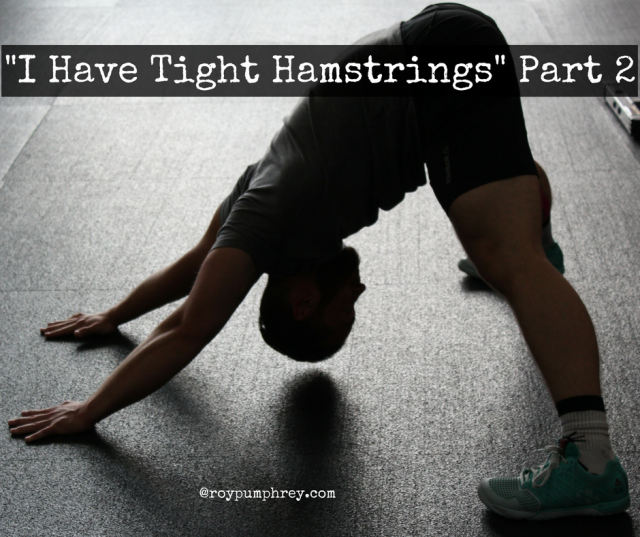
Last time we dealt with the dreaded No Ass Syndrome and how that can give you some tight hamstrings.
This week we’ll take on the most common culprit.
No Core….
And the overactive, super tight quads that follow.
I affectionally call this the Duck Butt, but the technical term is
Anterior Pelvic Tilt
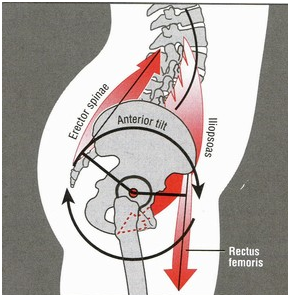
Basically, the pelvis, the bowl of water is tipped forward.
Before we get any farther, some degree of Anterior Pelvic Tilt is pretty common and can be considered “normal” posture.
In fact anterior pelvic tilt is the most common postural adaptation in athletes:
“The most commonly reported sport-specific postural adaptations of the trunk and hip region are lordosis and anterior pelvic tilt. Lordosis is considered to be an increase in the anterior curve of the lumbar spine resulting in an anterior tilt of the pelvis” –Kritz, Cronin
And, to a certain degree, may actually be a positive sprinting adaptation.
Wait, But What?
Very few people have perfectly neutral pelvis all, or even most, of the time.
“85% of males and 75% of females presented with an anterior pelvic tilt, 6% of males and 7% of females with a posterior tilt and 9% of males and 18% of females presented as neutral.” –Herrington
What Brings About Excessive Anterior Pelvic Tilt?
It’s usually a combination of things (like most postural adaptations):
- Tight Spinal Erectors
- Tight Hip Flexors
- Weak Glutes
- Weak Abs
“This pattern is characterized by overextension of the lumbar spine, lack of glute involvement, and quad and low-back dominance. These visual cues, in combination with a screening that reveals stiff hip flexors, poor glute and abdominal strength, and compensation patterns are good indicators of anterior pelvic tilt.” –Eric Garnas
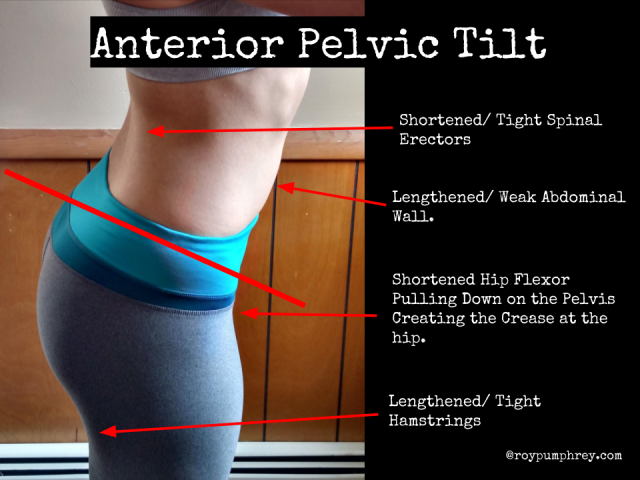
So Anterior Pelvic Tilt isn’t just ONE THING.
And when it comes to correcting it the best/ fastest/ most lasting results will come from attacking all of the above.
But, as far as APT (Anterior Pelvic Tilt) is concerned if I had to focus on one culprit its the tension in the quads, specifically the rectus femoris that is creating the tilt.
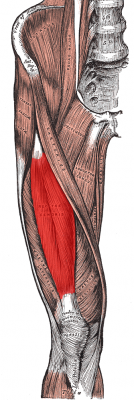
The rectus femoris is the highlighted one.
In most of the clients I’ve seen with APT the quads are wound up and yanking the pelvis down.
Much like the hamstrings in Posterior Pelvic Tilt the quads in Anterior Pelvic Tilt are trying to do a job they’re poorly suited for ….
Stabilize the Pelvis:
“If the pelvis is inadequately stabilized by other muscles, a sufficiently strong force from the rectus femoris (or any other hip flexor muscle) could rotate or tilt the pelvis anteriorly.” – Neuman
Stretch Your Hip Flexors Right?
NO
Endlessly Stretching Your Hip Flexors Wont Fix APT
So don’t do it.
*Unless you do it right which involves maintaining a neutral pelvis and HARD contraction of the glutes and obliques during the stretch.
Do it wrong?
You’ll only feed the beast.
And even if you stretch the hip flexors correctly the “change” will be temporary because there wont be sufficient muscle force to pull the pelvis into a more neutral alignment.
*Just so we’re all on the same page: the hip flexor stretch is a GREAT stretch and almost everyone should do it. It just wont “cure” your APT
You Need Abs
A “core” that functions.
One the braces at the onset of muscle action and helps stabilize and “set” the pelvis in place from the onset of force.
“Without sufficient stabilization of the pelvis by the abdominal muscles, a strong contraction of the hip flexor muscles may inadvertently tilt the pelvis anteriorly. An excessive anterior tilt of the pelvis typically accentuates the lumbar lordosis. “– Neuman
What’s this Have to Do With My Tight Hamstrings?
Anterior Pelvic Tilt, tight hip flexors, pulls the pelvis down in the front, driving the pelvis up in the back.
Effectively, Putting The Hamstrings On Stretch
ALL THE TIME
They never get to be at a normal, resting length.
The “normal” is now an overstretched position.
So wouldn’t a chronically overstretched muscle be/ feel “tight”?
Me thinks that’s a yes…
Especially if the muscle is stretched and weak and just about everyone has weak(ish) hamstrings.
Strong(er) hamstrings could help by pulling the “Sit Bone” down, counteracting the pull of the hip flexors.
Theoretically, stronger hamstrings would result in a more neutral pelvis, putting the hamstrings back to a more “normal” resting length.
But that’s not what I typically see in the real world.
In my experience, if you’ve got some serious APT going on, strengthening the hamstrings (without strengthening the core)
ONLY MAKES THE HAMSTRINGS FEEL TIGHTER
And doesn’t fix the Anterior Tilt of the Pelvis.
You Need More Abs Bro
Getting the core stronger and training it to fire reflexively to stabilize the pelvis has the greatest effect on “tight” hamstrings from APT by:
- “Setting” the pelvis
- Pulling up on the front of the pelvis
- Allowing the hip flexors to release (they no longer have to provide tension to stabilize the pelvis) and can return to normal length
- Dropping the back of the pelvis
- Allowing the hamstrings to return to normal length
Crying Wont Help Ya,
Sit-ups and Crunches Wont do Ya No Good
They almost never do….
You Need a REFLEXIVE Core.
NOT a core that creates motion, but one that stabilizes the pelvis in response to forces incurred. <—-change in posture, direction and magnitude of force, base and points of support.
#1: Pay Attention to Daily Posture
If you stand all day hanging off your low back, you’re not going to improve APT.
Your hamstrings are going to remain overstretched and feel tight.
The “dose” from being in this posture all day, every day, is just too large for anything done in the gym to counteract APT alone.
Bro Tip:
If you stand a lot or anterior pelvic tilt is your default posture stand tall and squeeze your butt OFTEN.
Checklist:
- Feet straight (arches on, not collapsed, feet rooted)
- STAND UP, no flexed ankles or knees
- Ribcage on the abs
- Pelvis neutral
- SQEEZE your glutes HARD for 5-15 seconds
When in doubt, put your fingers in your abs.
If you feel the abdominal wall turn on when you squeeze your glutes, congratulations!
You’re in a neutral posture and you did this drill correctly.
Don’t laugh.
You’d be surprised how many people can’t do this correctly.
Make sure you’re not one of them.
#2: Floor Based Movements to Start
Take joints out of the movement so you can get a feel for pelvic position.
Floor based movements give you the most control and feedback.
- Side Plank
- Birddogs
- Deadbugs
#3: Obliques
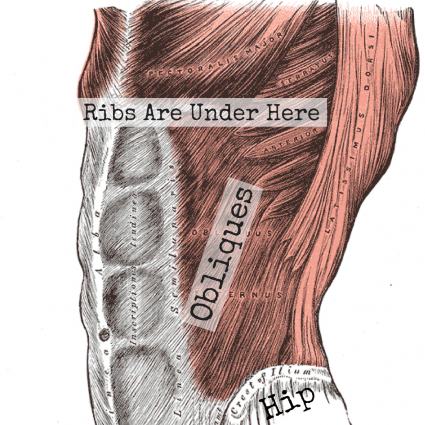 Obliques tie the ribcage to the hip.
Obliques tie the ribcage to the hip.
The obliques are key to achieving and maintaining the neutral spine/ “Cylinder” position.
So train the hell out of them.
#4: Tall and Half Kneeling:
Anything in half and tall kneeling works.
For these to be effective you MUST remain in a NEUTRAL pelvis, glute ON the whole time.
Overarch the lower back, drop the pelvis and you’re FEEDING THE BEAST.
But(t) A Weak Ass Is to Blame Too Right?
Yeah, you need a strong ass, but we’ve kinda already gone over that.
I cover that, like every week.
Its getting redundant.
Here, I’m going to give you a cheat sheet for most injuries and postural issues.
When in doubt, you can never have enough:
Upper Back, Ass and Abs.
*Much of the info in this article was guided by stolen from this Epic POST on Anterior Pelvic Tilt from Bret Contreras


